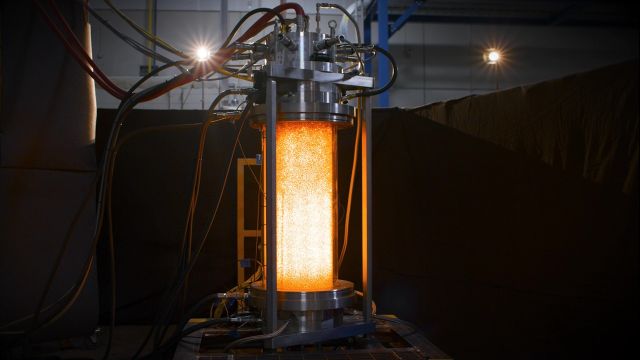
Reactor cell during factory acceptance testing (Source: Syzygy Plasmonics)
Burning natural gas to create a chemical reaction that produces hydrogen may not be considered the cleanest or least energy intensive production method.
But one company is developing technology that could revolutionize techniques used by chemical plants and refineries for decades to produce hydrogen. Houston-based Syzygy (pronounced si-zuh-jee) is developing combustion-free photoreactors that use light instead of heat to catalyze reactions to produce zero- and low-emissions hydrogen and other chemicals. The technology utilizes a photocatalyst developed by researchers at Rice University.
“This tech is built out of lower cost materials. Because we don’t have to burn fuel, the conditions inside a reactor are very mild, so it’s cheap to build. It runs extremely efficiently. We have a light source that is 95% efficient at turning electrons into photons,” Syzygy Plasmonics CEO Trevor Best told Hart Energy. “What this means is the overall energy efficiency of our reactor cell is close to 80%, which is best in class. Very high efficiency means low operating cost. Cheap materials mean low capital cost. Running on renewable electricity means no emissions. So, we are that cheap and clean alternative for the energy industry.”

The technology based on plasmonics—a field focused on how light interacts with metallic nanoparticles and nanostructures—is advancing as the world seeks lower carbon energy sources to lower emissions. Hydrogen is considered a promising pathway given its versatility and lack of greenhouse gas emissions.
Best believes Syzygy’s technology can do for refineries and chemical plants what the smartphone did for telecommunications and what semiconductors did for computing.
“We very strongly believe that this technology has the possibility to disrupt the entire space,” he said.
Plasmonic effect
Today, steam methane reforming (SMR) is the most common production method for hydrogen. With SMR, methane reacts with high-temperature steam and contacts a catalyst to produce hydrogen and CO2. However, the process, which takes place in a reactor, is energy intensive, requires a massive amount of heat and produces CO2 emissions.
Syzygy’s technology eliminates the need to burn natural gas to make the chemical reaction. Instead, a potentially game-changing photocatalyst—discovered by researchers Naomi Halas and Peter Nordlander at Rice University in 2016—uses light photons to drive chemical reactions. The researchers placed a nanoparticle of a traditional catalyst material into a larger plasmonic nanoparticle that harvested light, significantly improving capture and light transfer efficiency, Syzygy said.
Best describes the photocatalyst as being more efficient, more stable, more active and cheaper.
“Its performance was off the charts, [but] no one had ever made a chemical reactor that could use this type of catalyst at scale to make clean molecules for the industry,” Best said. “We quickly imagined a chemical reactor driven by artificial light, which is powered by renewable electricity that can make many different kinds of molecules without producing emissions.”
The photocatalysts are used in Syzygy’s Rigel reactor cells. Each photoreactor, which are about 6.5 ft tall and 2.5 ft wide, features a photocatalyst-filled sleeve surrounded by a light box. Banks of the photoreactors can be stacked, ranging from 1 ton of product per day to 100 tons or more per day, the company explains on its website. When the reactor is turned on, the photocatalysts inside the reactor are activated by photons from the light. This sets off trillions of reactions per second.
The result: low carbon intensity chemicals, sustainable fuels, renewable methanol or zero- or low-emissions hydrogen when renewable electricity powers the light sources. Different catalysts and feeds are used to produce hydrogen or other products.
In comparison
When using the technology to produce hydrogen, the steam reforming process is essentially the same as traditional steam reforming, Best said.
“The key differences with ours is in a traditional steam reformer, you power the unit by burning fuel, and this is about 40% of your total emissions,” Best said. That 40% is eliminated when renewable electricity is used. “The rest of the emissions that are made in what is called the process gas. This is actually not from burning, but from turning the CH4 and water into hydrogen and CO2. That CO2 is very concentrated and much easier to do carbon capture on than the combustion piece. … Ultimately we can reduce the cost of blue hydrogen by about 20%.”
Overall costs are dependent on the price of renewable electricity.
The technology also requires less power when compared to electrolysis, the process in which renewable energy is used to split water molecules into hydrogen and oxygen.
“To get one kilogram of hydrogen out of an electrolyzer, you need 50 [kilowatt hours] to 60 kilowatt hours,” Best said. “If you want one kilogram of hydrogen from our processes, you need 10 [kilowatt hours] to 15 kilowatt hours.”
But “The more expensive electricity gets, the more challenging it is for us,” Best said.
The same can be said of technologies that depend on natural gas in places where it is more expensive.
“All technologies are good and have a place,” he said, later adding “We view our technology as being applicable in about 70% of global geographies based off of the input prices or power and feed there.”
Going to market
Plasmonic photochemistry is no longer futuristic.
“It’s actually happening right now. We have a manufacturing program that can produce thousands of these cells and has been running for thousands and thousands of hours at multiple facilities around the world,” Best said. The company’s industrial demonstration facility is located in Pearland, Texas, just outside of Houston. “We are at the cusp of disrupting this marketplace.”

Syzygy has completed field trials with Equinor and Sumitomo Corp. in North Carolina, where the technology was used to create synfuels, and with Lotte Fine Chemical and Sumitomo for ammonia splitting in South Korea.
The technology has reached Level 8 on the Technology Readiness Level (TRL) scale. The company hopes to reach TRL 9 in about two years, Best said.
In all, Syzygy is advancing three commercial demonstrations. “They should be ready to turn on and get first fuel in Q1 of 2026,” he said.
“Ultimately, we want to be a licensor and OEM [original equipment manufacturer],” Best added.
Integrated oil and gas companies that operate refineries are among Syzygy’s targeted customers as well as chemical plants and industrial gas companies that supply hydrogen.
“We are very unique from a technology standpoint. We are the only ones bringing plasmonic photochemistry to market globally,” Best said, speaking on what sets Syzygy apart from other climate tech startups seeking investors. “What people are seeing in us that they are not necessarily seeing in other places in clean tech is the ability to achieve positive return rates for projects … I think a lot of clean tech just can’t clear that because it’s economically challenged. But we can.”
Syzygy is one of 20 companies invited to participate in the Gastech Startup Competition in Houston. A win here could help showcase the company as a leader in this space, Best said.
“Many of the people who are going to be in attendance probably still view us as early stage, as a science project. They haven’t seen our industrial demonstration plant run. They haven't seen the industrial cell that has been running thousands of hours,” he said. “If you go back to one year ago, we didn’t have those things. I think a win here can help us show the world how far we’ve come, and that we are ready to bring this tech to market in a time of humanity’s greatest need.”
Recommended Reading
Trump Fires Off Energy Executive Orders on Alaska, LNG, EVs
2025-01-21 - President Donald Trump opened his term with a flurry of executive orders, many reversing the Biden administration’s policies on LNG permitting, the Paris Agreement and drilling in Alaska.
Belcher: Trump’s Policies Could Impact Global Energy Markets
2025-01-24 - At their worst, Trump’s new energy policies could restrict the movement of global commerce and at their best increase interest rates and costs.
CEO: TotalEnergies to Expand US LNG Investment Over Next Decade
2025-02-06 - TotalEnergies' investments could include expansion projects at its Cameron LNG and Rio Grande LNG facilities on the Gulf of Mexico, CEO Patrick Pouyanne said.
Pickering Prognosticates 2025 Political Winds and Shale M&A
2025-01-14 - For oil and gas, big M&A deals will probably encounter less resistance, tariffs could be a threat and the industry will likely shrug off “drill, baby, drill” entreaties.
Analysts: DOE’s LNG Study Will Result in Few Policy Changes
2024-12-18 - However, the Department of Energy’s most recent report will likely be used in lawsuits against ongoing and future LNG export facilities.
Comments
Add new comment
This conversation is moderated according to Hart Energy community rules. Please read the rules before joining the discussion. If you’re experiencing any technical problems, please contact our customer care team.





